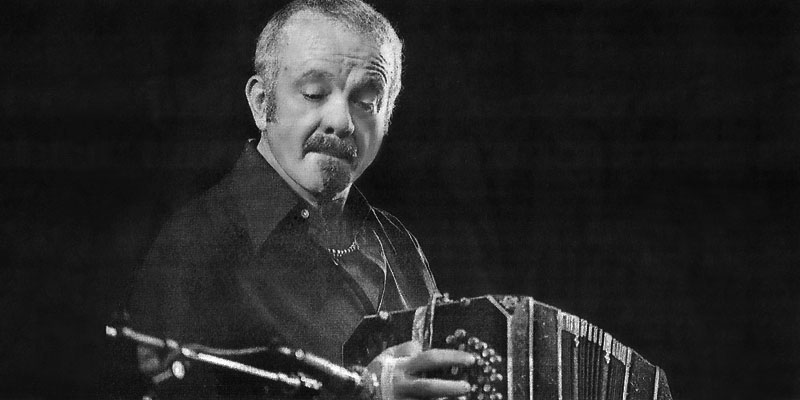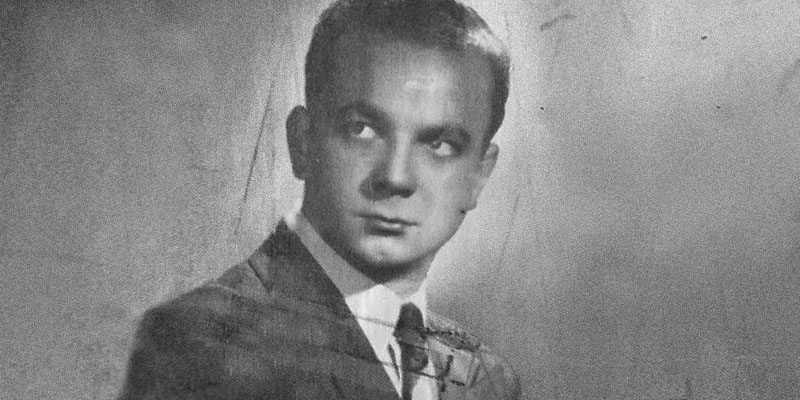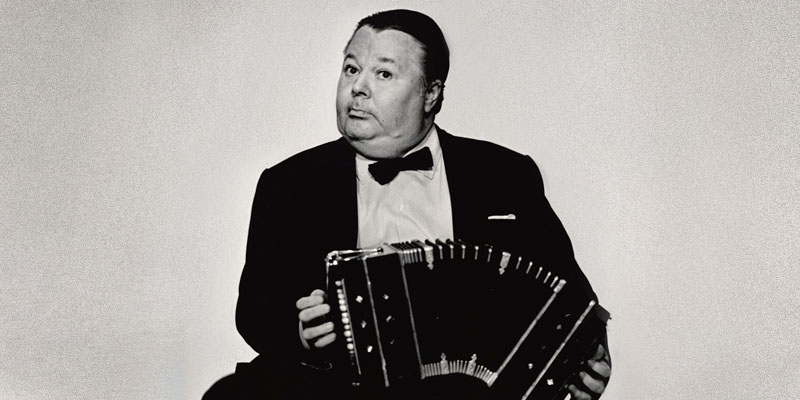We explore the life of Astor Piazzolla and his contributions to traditional Argentine music. In addition, we discuss why he is considered one of the most influential musicians of the 20th century.

Who was Astor Piazzolla?
Astor Piazzolla was an Argentine musician and composer, virtuoso bandoneon player, and key figure in the transformation of tango through the incorporation of elements from jazz and classical music, which gave rise to a new style called nuevo tango or avant-garde tango. He is considered the greatest tango composer in the world.
Piazzolla was born in Mar del Plata, and received his musical education in Europe and New York. Initially, his innovative musical ideas in a traditional genre like tango were rejected by orthodox tangueros (tango musicians and connoisseurs), who even dubbed him "the tango killer". His pieces were not played on the radio, and he was accused of being a snob.
However, in the late 20th century his work was rediscovered and his music gained widespread recognition both at the local and international levels. He was also a prominent composer of film music. Today, Piazzolla is considered the major innovator of tango music, and among the most prominent musicians of Argentina.
- See also: Rubén Darío
Birth and childhood of Astor Piazzolla
Astor Pantaleón Piazzolla was born in the coastal city of Mar del Plata, in the Buenos Aires Province (Argentina), on March 11, 1921. His parents, Vicente Piazzolla and Asunta Manetti, were born to Italian immigrants from southern and northern Italy. They named their child Astor after a friend of his father’s, Astor Bolognini, a cellist of the Chicago Symphony Orchestra.
When Astor was only three years old, his family moved to New York City, where he spent the remainder of his childhood. His father, an amateur musician and accordion player, gave Astor a bandoneon as a gift when he was eight years old, and the boy showed his virtuosity by learning to play it on his own.
While in New York, he took his first music lessons, and became acquainted with European immigrants, aficionados of classical music. Among them were the Hungarian pianist Bela Wilda, a disciple of Sergei Rachmaninov, and the Argentine Terig Tucci (1897-1973). It was during a brief visit to Argentina, at the age of eleven, that he had his first bandoneon lesson from a teacher: Libero Paolini, an Italian immigrant, and later continued his training with his brother Homero. From them, Astor learned his first polkas, rancheras, and waltzes.
While in the United States, he met Carlos Gardel (1890-1935), and had the opportunity to show him how he played the bandoneon. Gardel then invited him to join him on what would be his last tour: El día que me quieras. Astor's father thought his son was still too young to travel and did not allow it, which proved to be a fortunate decision, as during that Latin American tour, the plane carrying Gardel and his musicians crashed, killing everyone on board.
In 1936, when Astor was fifteen, his family decided to return to their homeland. Back in Mar del Plata, Astor began to play in several tango orchestras. Some time later, at the age of seventeen, he moved to the capital city, Buenos Aires.
Piazzolla in Buenos Aires

Piazzolla arrived in Buenos Aires at the age of seventeen, where he began to play with an orchestra at the Novelty cabaret. Soon after arriving in the capital city, he became acquainted with renowned bandoneonists, such as Pedro Maffia (1899-1967), Pedro Laurenz (1902-1972) and particularly Aníbal Troilo (1914-1975), nicknamed "Pichuco", with whom he developed a close friendship. Every night, after his own performance, the young Piazzolla would rush to the Germinal café on Corrientes Avenue, where the tango artists of the time gathered, to listen Troilo play and learn his repertoire by heart.
His closeness with Hugo Baralis, violinist in Troilo's band, gave him the chance to stand in for bandoneonist "Toto" Rodríguez (1919-2004) one night when he was ill. “Pichuco” himself put him to the test: Piazzolla was handed a bandoneon, and he proved he knew all the pieces. Troilo then approached him and said: “That suit won't do, kid. Get yourself a blue one; you're making your debut tonight”. It was December 1939, and Piazzolla had passed his baptism of fire.
A similar situation occurred during the visit of pianist Arthur Rubinstein (1887-1982) to Buenos Aires in 1940. The young Piazzolla went to the Palacio Álzaga Unzué, where Rubinstein was staying, and presented him with a sketch of a piano concerto. They reviewed it together, and Rubinstein was so impressed by the young Argentine's talent that he offered to take him as a pupil. However, it was the Argentine composer Alberto Ginastera (1916-1983), one of the most prominent 20th-century composers in the Americas, who would eventually take on the task.
Piazzolla took lessons from Ginastera between 1939 and 1945. Following his advice, he attended the performances by the great European musicians who arrived in Buenos Aires fleeing World War II, including artists like the Austrian Erich Kleiber (1890-1956), the German Walter Gieseking (1895-1956), the Russian Aaron Copland (1900-1990), and the Spanish Manuel de Falla (1876-1946).
Around that time, Piazzolla met Odette María Wolf (nicknamed "Dedé"), an art student with whom he discovered the avant-garde trends in art. Soon their relationship evolved and they got married at the end of 1942, later moving to an apartment in the Montserrat neighborhood. The following year, their first daughter, Diana, was born, and in 1944, their second child, named Daniel.
Piazzolla after "Pichuco"

Piazzolla was part of Anibal Troilo's ensemble until 1944. Nicknamed "Gato" by the famous bandoneonist due to his nocturnal lifestyle, they forged an extremely close relationship. Not only were they friends: Troilo gradually gave him more and more artistic responsibility in his orchestra.
So it was that, due to an indisposition of Troilo's official arranger, Argentino Galván, Piazzolla was commissioned to arrange the candombe "Azabache", which Troilo entered in a tango radio contest. To Troilo's delight, the piece won the contest and new opportunities opened up for Piazzolla.
Yet, there were periods of creative differences between them. Although Troilo was a "musical father" to Piazzolla, the young man's arrangements tended to be more complex and ambitious: Piazzolla was not content to only serve entertainment, and felt that Troilo had stopped evolving since his 1940 repertoire, refusing to reinvent himself for purely sentimental reasons.
In 1943, the tango "Inspiración" came out, which was Piazzolla's first arrangement for Pichuco’s ensemble and the first to be recorded. The piece was very successful, even though it evidenced Piazzolla's daring arrangements, many of which were toned down on Troilo's instruction. "For every thousand notes I composed, he would erase seven hundred", Piazzolla stated years later.
The piece was recorded with several record labels and was among the first that Piazzolla would perform some years later with his own ensemble. This took place in 1946, two years after he had left his teacher and friend Troilo's orchestra.
His first solo steps were with singer Francisco Fiorentino (1905-1955), who announced himself to be performing with "Piazzolla's orchestra", which is evidence of the stature that Astor already had among Argentine musicians. His idea of tango was not so much concerned with dancing, but rather with listening to the music.
Between 1944 and 1949, Piazzolla had his own independent orchestra, working with the Odeón record label. During that period, he devoted his efforts mainly to composition and arrangements, especially for ensembles like the Orquesta Típica Francini-Pontier, the orchestra of José Hipólito Basso (1919-1993), and even for his former ensemble, still conducted by Troilo. Many of these arrangements earned him the mistrust of other tangueros, who accused him of being pretentious and moving away from the fundamentals of true tango.
During the 1950s, Piazzolla disbanded his orchestra and devoted himself entirely to making arrangements and "custom" compositions for other ensembles and orchestras. During that period, he composed renowned pieces such as "Contrabajeando", "Prepárense", "Triunfal", "Lo que vendrá", and "Para lucirse".
Despite the enthusiasm expressed by a broad sector of the musical critique, the more orthodox tangueros continued to oppose Piazzolla. They dubbed him "the tango killer" and labeled him a snob, accusing him of not really composing tangos, but something completely different. To such accusations, Piazzolla responded with a new definition of what he did: "contemporary music of Buenos Aires". In a 1954 interview for Antena magazine, Piazzolla said about it:
"Yes, it is true, I am an enemy of tango; but of the tango as they understand it. They still believe in the “compadrito”, I do not. They believe in the “farolito”, I do not. If everything has changed, so must the music of Buenos Aires. Many among us want to change the tango, but these gentlemen who attack me do not understand it and never will. I will go on, in spite of them."
The stay in Europe
In 1953 Piazzolla won the Fabien Sevitzky composition prize with Buenos Aires (tres movimientos sinfónicos). The prize consisted of a monetary reward and the performance of the winning piece by Fabien Sevitzky himself. The performance took place that same year amid a scandal, as classical musicians were not accustomed to seeing a bandoneon on stage.
Throughout his career, Piazzolla faced prejudice towards his instrument, typical of the popular music of Buenos Aires. That may explain why he never recorded the award-winning composition, and the fact that during his stay in Europe he would hide his bandoneon so that no one would know he played it. Piazzolla was torn between being a tango musician and a composer of cultivated music.
With the prize money, he decided to go to France, where he studied with composer, pianist and conductor Nadia Boulanger (1887-1979), of whom he later said: "She taught me to believe in Astor Piazzolla, that my music was not as bad as I thought it was". With her, Piazzolla managed to reconcile his interests in tango and cultivated music: it was not about choosing one or the other; it was about cultivating both genres.
He studied with Boulanger for eleven months, and formed a string orchestra with several musicians from the Paris Opera, and with Lalo Schifrin (1932-) and Martial Solal (1927-) alternating on the piano. There he discovered not only that tango was appreciated and danced in Paris, but also that his piece “Prepárense” was part of the local repertoires. In 1955, he recorded the album Two Argentinians In Paris, with pieces like “Picasso,” “Luz y sombra”, and “Bandó”.
From that moment on, Piazzolla's output changed radically. He was determined, as his friend Lalo Schifrin had suggested, to "be Piazzolla", that is, to compose without worrying about whether or not he was breaking the rules of traditional tango.
In 1955, Astor returned from Paris and set up the Octeto Buenos Aires in Argentina, which was committed to modernizing traditional music. In this new ensemble, he incorporated elements of jazz and swing, as well as the counterpoint typical of classical music. Without a singer, except on rare occasions, and with no intention of prompting people to dance, the Octeto set out to "do tango the way it feels".
The Octeto was composed of Piazzolla and Leopoldo Federico (bandoneons), Enrique Mario Francini and Hugo Baralis (violins), Atilio Stampone (piano), Horacio Malvicino (electric guitar), José Bragato (cello), and Hamlet Greco (double bass), though the latter was later replaced by Juan Vasallo. Their first performance was at the Faculty of Law of Buenos Aires in the late 1957, and they recorded two albums: Tango progresivo and Tango moderno.
During that period, Piazzolla was the conductor of a string orchestra alongside other Argentine musicians. It was at that time that he proposed a new system for interpreting tango, which established him as a true tango theorist.
In 1958, the political situation in Argentina prompted him to move back to the United States, and he therefore disbanded his two ensembles, returning with his family to New York. The following year, while on tour in Central America, he received the news of his father's death, which brought him to compose "Adiós Nonino" in his honor, probably the most famous tango of his entire body of work.
Tango Nuevo and critical acclaim
In 1960, Piazzolla returned to Buenos Aires and set up the orchestra in which he could best express his vision of tango and traditional Buenos Aires music: Quinteto Tango Nuevo, which, in addition to bandoneon and piano, included violin, electric guitar, and double bass. Alongside Piazzolla in this ensemble were musicians Jaime Gosis (1913-1975), Simón Bajour (1928-2005), Kicho Díaz (1918-1992), and Horacio Malvicino (1929-).
With the Quinteto, Piazzolla premiered many of his greatest works, including “Adiós Nonino,” Estaciones porteñas, “Buenos Aires Hora Cero”, Serie del Ángel, and Serie del Diablo, among others.
Three years later, he formed Nuevo Octeto, with which he devoted himself to setting the works of writer Ernesto Sabato (1911-2011) to music, receiving the Hirsch Prize for his series of symphonic tangos. In 1965, he set several poems by Jorge Luis Borges (1899-1986) to music.
In 1966, Piazzolla separated from his wife Dedé Wolff. During those years, he began a fruitful partnership with the Uruguayan writer and tango historian Horacio Ferrer (1933-2014). Together they composed the “operita” María de Buenos Aires, premiered in 1968 with the Argentine singer Amelita Baltar (1940-), with whom Piazzolla began a relationship that would last several years. In 1970, he left Argentina again for Paris, accompanied by Ferrer to perform a series of concerts in Europe.
In 1973, Piazzolla suffered a heart attack. He then decided to settle in Italy and slow down his work pace. He stayed there for five years, during which time he set up a new octet, called Conjunto Eléctrico, alongside renowned Italian musicians of the time. While in Italy, he learned of the death of his friend Aníbal Troilo in 1975, and composed the Suite Troileana in his honor, a four-movement composition that he recorded with Conjunto Eléctrico.
The following year, he began a love affair with Laura Escalada, with whom he would spend the rest of his days. During those years, he composed some of his most famous pieces, such as "Libertango" (1974) and Le Grand Tango (1982), the latter with Quinteto Tango Nuevo.
During the 1980s, at the peak of his fame, Piazzolla was named an Illustrious Citizen of the City of Buenos Aires, and received the Konex Platinum Award as the best avant-garde tango musician in Argentine history. In 1983, he was invited for the first time to perform at the Teatro Colón in Buenos Aires.
Death and legacy of Astor Piazzolla
Astor Piazzolla formed Quinteto Tango Nuevo in 1960, with which he popularized some of his most famous pieces.
By the late 1980s, Piazzolla had begun to show clear signs of deteriorating health. In 1988, he underwent heart surgery and a quadruple bypass, shortly before setting up his last ensemble, Sexteto Nuevo Tango.
In 1989, he composed the famous tango "Vuelvo al Sur", with lyrics by the Argentine director Francisco "Pino" Solanas (1936-2020), for his film Sur. This piece also served as a tribute to the tango "Sur" by his teacher and friend Aníbal Troilo.
During a stay in Paris in 1990, he suffered a thrombosis and was admitted to hospital with a stroke from which he never recovered. He was transferred to Buenos Aires in August that same year, where he died two years later, on July 4, 1992, at the age of 71.
In his final ten years, Piazzolla composed around three hundred tangos and several dozen film soundtracks. Many of these pieces received posthumous fame and recognition, including a Grammy Award nomination in 1992 for best soundtrack for his 1982 composition "Oblivion".
Today, he is considered the greatest innovator of the tango music and a central figure in the contemporary culture of Buenos Aires. Numerous tango ensembles perform and adapt his compositions, and pay open tribute to him by creating new variants of tango, incorporating electronics and other contemporary musical styles.
Among the most iconic compositions by Astor Piazzolla are:
- "Adiós Nonino" (1959)
- "Buenos Aires Hora Cero" (1963)
- "Balada para un loco" (1969).
- "Libertango" (1974)
- "Whisky" (1975)
- Le Grand Tango (1982)
- "Vuelvo al Sur" (1988).
- María de Buenos Aires (1968)
Explore next:
References
- Azzi, M. (2020). Astor Piazzolla. El Ateneo.
- Fundación Astor Piazzolla. (2023). Acerca de su vida y obra. Astor Piazzolla (1921-1992). https://fundacionastorpiazzolla.org.ar/
- Pintos, G. (2021). Astor Piazzolla, el hombre que rompió los límites del tango y creó una nueva sensibilidad. Infobae. https://www.infobae.com/
- Presidencia de la Nación Argentina. (s. f.). Astor Piazzolla. Museo del Bicentenario. https://www.argentina.gob.ar/
- The Encyclopaedia Britannica. (2023). “Astor Piazzolla”. https://www.britannica.com/
Was this information useful to you?
Yes NoThank you for visiting us :)